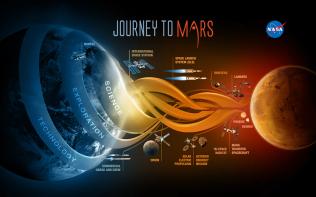
Nasa's MAVEN (Mars Atmosphere and Volatile Evolution Mission) spacecraft, which has been orbiting Mars since 2014, has been gathering data that will allow scientists to understand changes in the upper atmosphere of the Red Planet.
It is known that Mars, billions of years ago, had atmosphere and water and could have supported life. It is now barren and cold.
What Mars now has is a thin atmosphere–and even this is at risk, say scientists who have discovered that the planet has a twisted tail.
The process that created this tail could also allow some of Mars' already thin atmosphere to escape to space.
Mars' magnetic tail, or magnetotail, is unique in the solar system. It's not like the magnetotail found at Venus, a planet with no magnetic field of its own, nor is it like Earth's, which is surrounded by its own internally generated magnetic field.
Instead, it is a hybrid between the two.
The team found that a process called "magnetic reconnection” must have a big role in creating the Martian magnetotail because, if reconnection were occurring, it would put the twist in the tail.
A model the scientists built suggested that such reconnection would cause the planet's tail to twist 45 degrees from what is expected, based on the direction of the magnetic field carried by the solar wind, the scientist explained.
The model was found to be in agreement with readings based on MAVEN data.
Mars lost its global magnetic field billions of years ago and now just has remnant ‘fossil' magnetic fields embedded in certain regions of its surface.
Mars' magnetotail is formed when magnetic fields carried by the solar wind join with the magnetic fields embedded in the Martian surface in a process called magnetic reconnection.
The solar wind is a stream of electrically conducting gas continuously blowing from the Sun's surface into space at about one million miles (1.6 million kilometres) per hour.
It carries magnetic fields from the Sun with it.
If the solar wind field happens to be oriented in the opposite direction to a field in the Martian surface, the two fields join together in magnetic reconnection, such that the reconnection might propel some of the atmosphere of Mars into space.
Mars' upper atmosphere has electrically charged particles (ions), which respond to electric and magnetic forces and flow along magnetic field lines.
Since the Martian magnetotail is formed by linking surface magnetic fields to solar wind fields, ions in the Martian upper atmosphere have a pathway to space if they flow down the magnetotail.
Like a stretched rubber band suddenly snapping to a new shape, magnetic reconnection also releases energy, which could actively propel ions in the Martian atmosphere down the magnetotail into space.
MAVEN: Know More - Mars Atmosphere and Volatile EvolutioN Mission (MAVEN)[5] is a space probe developed by NASA designed to study the Martian atmosphere while orbiting Mars.
- Mission goals include determining how the planet's atmosphere and water, presumed to have once been substantial, were lost over time.
- MAVEN was successfully launched aboard an Atlas V launch vehicle at the beginning of the first launch window on November 18, 2013.
- Following the first engine burn of the Centaur second stage, the vehicle coasted in low Earth orbit for 27 minutes before a second Centaur burn of five minutes to insert it into a heliocentric Mars transit orbit.
- On September 22, 2014, MAVEN reached Mars and was inserted into an areocentric elliptic orbit 6,200 km (3,900 mi) by 150 km (93 mi) above the planet's surface.
- The principal investigator for the spacecraft is Bruce Jakosky of the Laboratory for Atmospheric and Space Physics at the University of Colorado Boulder.
- On November 5, 2015, NASA announced that data from MAVEN shows that the deterioration of Mars' atmosphere increases significantly during solar storms.
- Mars' gradual shift from its carbon dioxide-dominated atmosphere-which had kept Mars relatively warm and allowed the planet to support liquid surface water-to the cold, arid planet took place between about 4.2 and 3.7 billion years ago.